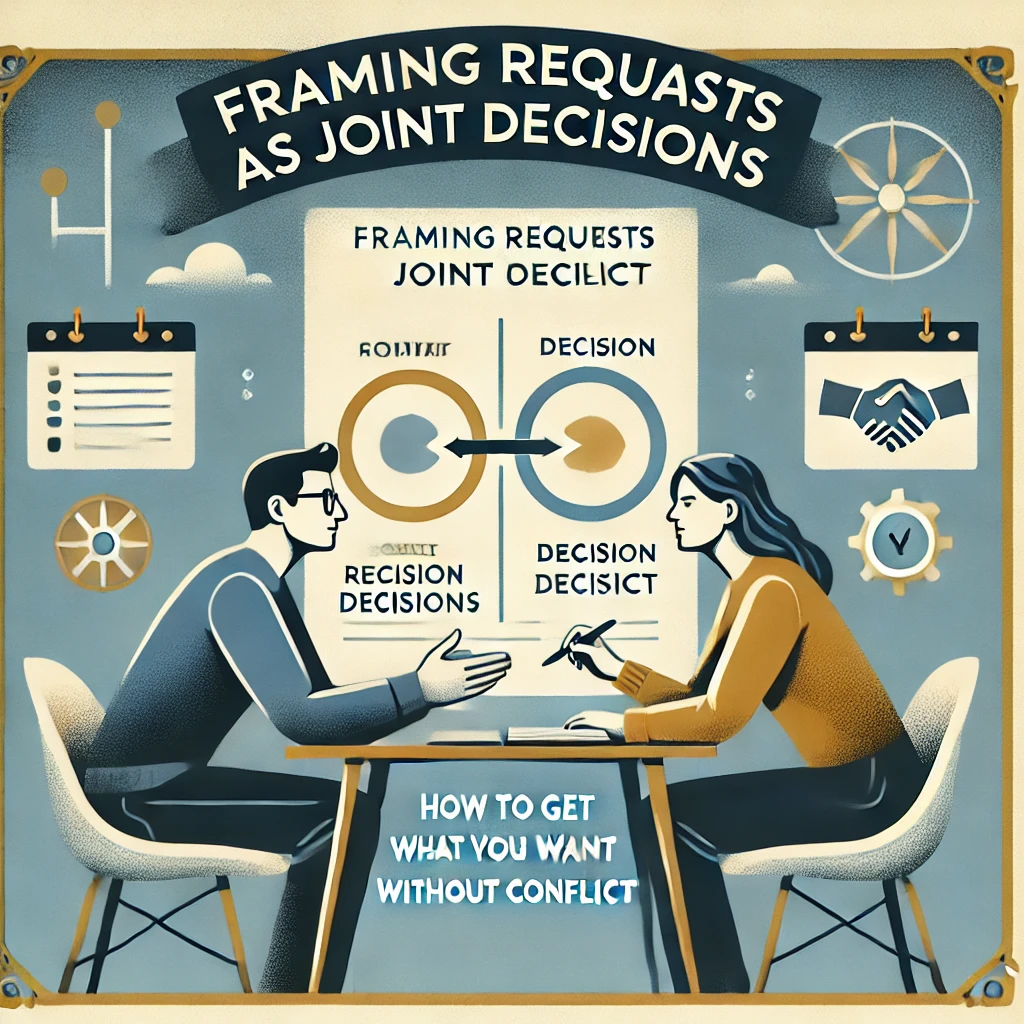Have you ever asked your partner for something, only to be met with resistance or hesitation? It could be a big decision, like where to move or how to budget, or something as small as what to do for the weekend. What if I told you there’s a way to ask for what you want that doesn’t feel like you’re making a demand or pressuring your partner? The solution lies in Framing Requests as Joint Decisions.
Instead of presenting requests as “my way or the highway” or even subtly pushing for what you want, framing your asks as joint decisions makes your partner feel equally involved. When you turn a request into a shared goal or a decision you’re both part of, you’re more likely to get a “yes”—and better yet, it builds mutual respect and trust.
In this blog, we’ll break down how to frame your requests as joint decisions, why this approach works so well in relationships, and provide real-life examples you can apply today. By the end, you’ll see how this simple shift in communication can help you achieve harmony in your relationship without conflict.
What Does It Mean to Frame Requests as Joint Decisions?
Framing requests as joint decisions means presenting what you want in a way that invites collaboration, rather than issuing a direct request or demand. It’s about making your partner feel like you’re both contributing to the decision-making process, rather than being told what to do. Instead of saying, “I want us to do X,” you rephrase it as, “What do you think about us doing X together?” or “How should we approach this decision?”
The key is to frame the conversation as a mutual problem-solving process where you both have input. This way, your partner feels more involved and less likely to resist because they’re part of the decision-making process.
Why Does Framing Requests as Joint Decisions Work?
This approach works because it taps into the human need for autonomy and collaboration. People don’t like feeling controlled or pressured, especially in relationships. When a decision feels like a shared process, it reduces the likelihood of defensiveness or resistance. Instead, your partner feels respected and involved, which makes them more willing to go along with the outcome.
By framing requests this way, you:
- Build Trust: Your partner feels heard and valued, which strengthens the bond between you.
- Reduce Resistance: When both partners feel they have a say, there’s less need for pushback or stubbornness.
- Encourage Cooperation: It fosters a sense of teamwork and mutual responsibility for decisions.
How to Frame Requests as Joint Decisions in Relationships
Now that you understand why this approach is so effective, let’s look at some real-life examples of how to use it in your relationship.
Example 1: Deciding on a Major Purchase Together
Let’s say you and your partner are discussing a big purchase—something like a new car, home renovation, or even a vacation. You know what you want, but you also want to avoid sounding demanding or like you’re pushing for one option.
How to Frame It as a Joint Decision:
Instead of saying, “I think we should buy this car,” reframe it as, “I’ve been looking at different options for the car we want. What are your thoughts on these two models? How do you think we should approach this?” By asking for their input and making them feel like they’re part of the decision-making process, you’re more likely to get the outcome you want without making it feel like a one-sided decision.
Why It Works:
You’re involving your partner in the decision from the start, which makes them feel like their opinion matters. When they feel like they have input, they’re more open to compromise and less likely to push back against your preferences.
Example 2: Planning Weekend Activities
You want to spend the weekend doing something specific, but your partner might have different ideas about how to spend the time. Rather than telling them what you want to do, turn it into a joint decision.
How to Frame It as a Joint Decision:
Instead of saying, “I want us to go hiking this Saturday,” rephrase it as, “What do you think we should do this weekend? I was thinking we could go hiking, but I’d love to hear your thoughts.” By inviting their opinion, you turn it into a shared decision, and they’re more likely to agree because they feel involved.
Why It Works:
You’re offering your preference but not in a way that excludes their input. This creates space for discussion and compromise, making it more likely that you’ll end up doing what you want without it feeling like you’ve imposed your plans.
Example 3: Negotiating Household Responsibilities
Chores are a common point of tension in many relationships, especially when one partner feels like they’re doing more than their fair share. Instead of demanding that your partner take on more responsibilities, turn the conversation into a joint decision about how to divide tasks fairly.
How to Frame It as a Joint Decision:
Rather than saying, “You need to help more with the chores,” try, “I’ve been thinking about how we can split the household tasks so it feels more balanced. What’s your take on how we should divide things?” This approach invites your partner to contribute to the solution, making them feel like it’s a mutual decision rather than a directive.
Why It Works:
By asking for their input on how to approach the issue, you avoid sounding accusatory or demanding. Instead, you create a cooperative atmosphere where you’re working together to find a solution.
Example 4: Budgeting as a Team
Money is often a source of stress in relationships, especially when partners have different spending habits. Framing financial decisions as joint ones can ease tension and lead to better cooperation.
How to Frame It as a Joint Decision:
Instead of saying, “We need to stop spending so much,” try, “I’ve been thinking about how we can better manage our budget. What do you think we should prioritize? How can we make sure we’re saving enough for what we want?” This approach turns a potentially stressful conversation into a collaborative one where both of you are working toward the same financial goals.
Why It Works:
By framing the conversation as a joint effort to manage finances, you’re reducing the likelihood of conflict and making your partner feel like they have a say in the solution. This fosters teamwork rather than division.
Example 5: Making Long-Term Plans
Whether it’s deciding where to live, how to approach family planning, or making big career moves, long-term decisions can create anxiety in a relationship if one partner feels like they don’t have enough control over the outcome. By framing long-term plans as joint decisions, you can navigate these conversations with less friction.
How to Frame It as a Joint Decision:
Instead of saying, “I think we should move to the city,” try, “We’ve been talking about where we want to live next, and I’d love to figure it out together. What do you think about exploring options in the city or maybe somewhere nearby?” This approach invites your partner to contribute to the discussion and offers space for them to share their perspective.
Why It Works:
Long-term decisions feel less daunting when both partners feel like they’re equally involved. By framing it as a joint decision, you’re reducing the stress that often comes with big choices and fostering a sense of shared responsibility.
Why Framing Requests as Joint Decisions Works in Relationships
Framing requests as joint decisions works because it shifts the dynamic from “me vs. you” to “us.” It emphasizes collaboration, respect, and shared responsibility for outcomes, which builds a stronger foundation for communication and trust in the relationship. Your partner is more likely to feel like an equal participant in the process, which reduces the likelihood of resistance or resentment.
This approach also fosters a sense of fairness. When both partners feel like their opinions and preferences are being considered, they’re more willing to cooperate and compromise, leading to smoother decision-making and less conflict.
Tips for Mastering the Art of Framing Requests as Joint Decisions
Here are some tips for effectively framing your requests as joint decisions:
- Ask Open-Ended Questions: Invite your partner’s input by asking open-ended questions like “What do you think?” or “How should we approach this?” This makes the conversation feel collaborative rather than directive.
- Be Genuine: Don’t just pretend to ask for their opinion—really listen to their perspective. The key to this technique working is making your partner feel heard and valued.
- Present Multiple Options: Offer a few potential solutions or options to make the decision-making process feel more balanced. This gives your partner the opportunity to weigh in without feeling pressured to choose your preferred option.
- Avoid Ultimatums: Framing requests as joint decisions only works if both partners feel like they have equal control. Avoid presenting options in a way that feels like an ultimatum or one-sided decision.
Q&A:
- How can I ask my partner for what I want without causing conflict?
Learn how framing your request as a joint decision can reduce resistance and make your partner more receptive. - What does it mean to frame a request as a joint decision in a relationship?
Framing a request as a joint decision means involving your partner in the decision-making process, making them feel like an equal participant. - Why does framing requests as joint decisions work in relationships?
This approach works because it taps into a sense of autonomy and collaboration, reducing defensiveness and promoting mutual respect. - How can I get my partner to agree on a big decision like moving or budgeting?
Presenting it as a joint decision, where both voices are valued, helps foster agreement without feeling like one person is in control. - What are some examples of framing requests as joint decisions?
Examples include asking for input on weekend plans, negotiating household chores, and discussing financial goals as shared objectives. - How do I make my partner feel involved in decision-making?
By asking open-ended questions and genuinely listening to their input, you create a collaborative atmosphere. - How can I use joint decision-making to improve communication with my partner?
Joint decision-making enhances communication by fostering a respectful exchange of ideas, making both partners feel heard and valued. - Can framing requests as joint decisions reduce relationship arguments?
Yes, this approach reduces the likelihood of conflict by ensuring both partners feel included, leading to smoother decision-making. - What are the benefits of using a joint decision-making approach in relationships?
Benefits include building trust, encouraging cooperation, and creating a sense of shared responsibility for decisions. - How do I frame a request as a joint decision without sounding manipulative?
Be sincere and ask open-ended questions, focusing on collaboration rather than steering your partner toward a predetermined answer.
Want to Master the Art of Influence in Your Relationship?
If you’re ready to take your communication and influence skills to the next level, “Mastering Him: The Secret Art of Gentle Control in Relationships” is your guide. In Chapter 5, you’ll dive deeper into the technique of Framing Requests as Joint Decisions and explore 12 other powerful strategies for influencing your partner’s behavior and decisions—without conflict or pressure.
Get your copy today and start mastering the art of influence in your relationship. It’s time to create harmony, cooperation, and mutual respect in all of your decisions—big and small.
Read more about the book: https://developmentpill.com/mastering-him-the-secret-art-of-gentle-control-in-relationships-a-guide-to-influence-hell-never-see-coming/
Book Link: https://www.amazon.com/dp/B0DKKGLZQ9
Book Link UK: https://www.amazon.co.uk/dp/B0DKKGLZQ9
You can find book Links for other regions in this post page: https://developmentpill.com/mastering-him-the-secret-art-of-gentle-control-in-relationships-a-guide-to-influence-hell-never-see-coming/



